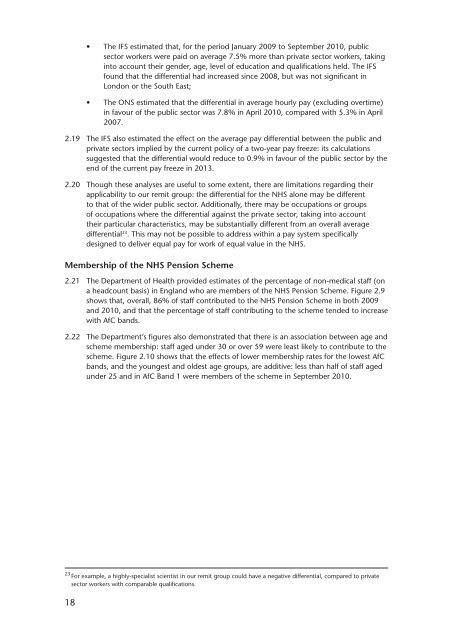NHS pay review body: twenty-sixth report 2012 - Official Documents
NHS pay review body: twenty-sixth report 2012 - Official Documents
NHS pay review body: twenty-sixth report 2012 - Official Documents
You also want an ePaper? Increase the reach of your titles
YUMPU automatically turns print PDFs into web optimized ePapers that Google loves.
18<br />
•<br />
•<br />
The IFS estimated that, for the period January 2009 to September 2010, public<br />
sector workers were paid on average 7.5% more than private sector workers, taking<br />
into account their gender, age, level of education and qualifications held. The IFS<br />
found that the differential had increased since 2008, but was not significant in<br />
London or the South East;<br />
The ONS estimated that the differential in average hourly <strong>pay</strong> (excluding overtime)<br />
in favour of the public sector was 7.8% in April 2010, compared with 5.3% in April<br />
2007.<br />
2.19 The IFS also estimated the effect on the average <strong>pay</strong> differential between the public and<br />
private sectors implied by the current policy of a two-year <strong>pay</strong> freeze: its calculations<br />
suggested that the differential would reduce to 0.9% in favour of the public sector by the<br />
end of the current <strong>pay</strong> freeze in 2013.<br />
2.20 Though these analyses are useful to some extent, there are limitations regarding their<br />
applicability to our remit group: the differential for the <strong>NHS</strong> alone may be different<br />
to that of the wider public sector. Additionally, there may be occupations or groups<br />
of occupations where the differential against the private sector, taking into account<br />
their particular characteristics, may be substantially different from an overall average<br />
differential23 . This may not be possible to address within a <strong>pay</strong> system specifically<br />
designed to deliver equal <strong>pay</strong> for work of equal value in the <strong>NHS</strong>.<br />
Membership of the <strong>NHS</strong> Pension Scheme<br />
2.21 The Department of Health provided estimates of the percentage of non-medical staff (on<br />
a headcount basis) in England who are members of the <strong>NHS</strong> Pension Scheme. Figure 2.9<br />
shows that, overall, 86% of staff contributed to the <strong>NHS</strong> Pension Scheme in both 2009<br />
and 2010, and that the percentage of staff contributing to the scheme tended to increase<br />
with AfC bands.<br />
2.22 The Department’s figures also demonstrated that there is an association between age and<br />
scheme membership: staff aged under 30 or over 59 were least likely to contribute to the<br />
scheme. Figure 2.10 shows that the effects of lower membership rates for the lowest AfC<br />
bands, and the youngest and oldest age groups, are additive: less than half of staff aged<br />
under 25 and in AfC Band 1 were members of the scheme in September 2010.<br />
23<br />
For example, a highly-specialist scientist in our remit group could have a negative differential, compared to private<br />
sector workers with comparable qualifications.
















